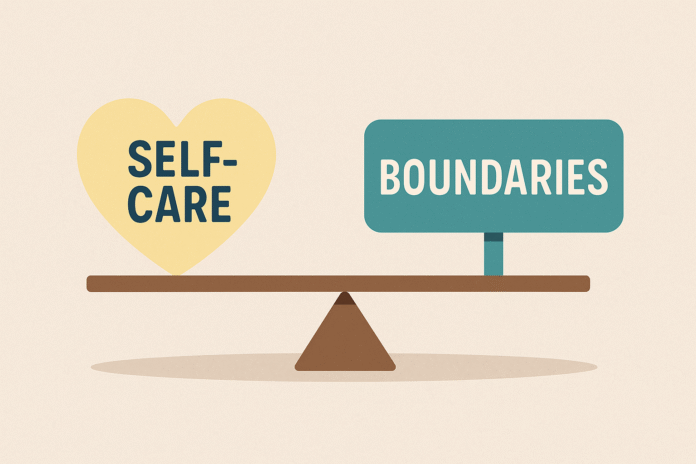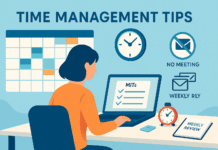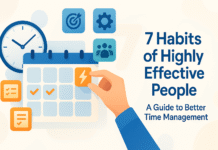You can’t pour from an empty cup—but you also can’t protect that cup with walls so high that you lose touch with what matters. This guide is about the balancing act between self-care (what refuels you) and setting boundaries (what protects you). You’ll learn practical, step-by-step ways to design both—without guilt—and how to measure whether your choices are actually working. It’s written for busy professionals, caregivers, creators, and anyone who keeps saying “I’ll rest when things calm down” (they rarely do).
Disclaimer: This guide is educational and does not replace personalized medical, mental-health, legal, or financial advice. For diagnosis or treatment decisions, consult a qualified professional.
Key takeaways
- Self-care and boundaries are complementary systems. Self-care restores your energy; boundaries protect it.
- Start with a baseline audit. Track energy, time leaks, and common boundary violations for a week.
- Build a “core four” of self-care (sleep, movement, mindfulness, connection) and design a boundary playbook (clear limits, scripts, escalation steps).
- Expect pushback. Guilt, people-pleasing, and unclear norms are normal hurdles—prepare scripts and a repair plan.
- Measure what matters. Use simple KPIs: energy score, sleep hours, boundary-respected rate, and “yes/no” ratio.
- Iterate weekly. Small, consistent adjustments beat heroic overhauls.
Foundations: What “balance” really means
What it is & core benefits
“Balance” isn’t a perfect 50/50 split between giving and guarding. It’s a fit-for-purpose rhythm where your self-care habits restore capacity and your boundaries keep that capacity from leaking. Together, they reduce overload, increase clarity, and protect relationships from resentment.
- Self-care = practices that replenish physical, mental, emotional, and social energy.
- Boundaries = communicated limits on your time, attention, and resources.
A balanced system makes demands more predictable, improves decision quality, and reduces the risk of work-related exhaustion often described as burnout.
Requirements / prerequisites
- A basic notebook or notes app.
- A calendar you actually use.
- Willingness to experiment for four weeks.
Step-by-step (beginner)
- Name your energy sources and drains. List what reliably restores you (sleep, walks, reading) and what drains you (late-night emails, unplanned favors).
- Choose two non-negotiables (e.g., bedtime and a 10-minute morning reset).
- Pick two boundaries you’ll practice for one week (e.g., “no meetings before 10,” “24-hour reply window”).
- Log results daily in one sentence: What helped? What leaked?
Beginner modifications & progressions
- Start with micro-habits (5–10 minutes) and soft boundaries (polite delays, gentle no’s).
- Progress to hard boundaries (blocked time, auto-declines) and deeper self-care blocks (30–60 minutes).
Recommended frequency / metrics
- Daily: 1–2 self-care actions; 1–2 boundary reps.
- Weekly: Review energy (1–10), sleep hours, and “boundary respected %.”
- KPI starter set: Energy average ≥7; sleep ≥7 hours on most nights; boundary respected ≥70%.
Safety, caveats, common mistakes
- A single perfect day tells you little; look for trend lines.
- Avoid weaponizing self-care (“I earned it, so I can ignore people”). Boundaries should be communicated, not silently imposed.
Mini-plan example
- Today: Block bedtime at 11 p.m.; set “Do Not Disturb” from 10 p.m.–7 a.m.; use one script to decline a non-urgent request.
Know your baseline: The one-week audit
What it is & benefits
A brief audit reveals where your time, energy, and attention actually go. It makes hidden obligations and boundary violations visible, so your fixes are targeted—not theoretical.
Requirements / low-cost alternatives
- Any calendar app, spreadsheet, or paper.
- Optional: a timer (phone) and a habit tracker (free templates work fine).
Step-by-step
- Track inputs (sleep start/stop, meals, movement, quiet time).
- Track demands (meetings, tasks, caregiving, commutes).
- Mark violations whenever you do something after you decided not to (e.g., post-bedtime scrolling, extra shift).
- Rate energy 1–10 every evening; jot one sentence on what helped/hurt.
- Tag each day with a theme: “overbooked,” “interrupted,” “just right.”
Beginner modifications & progressions
- If logging feels heavy, track only sleep, start/end work, and one boundary you care about.
- Progress to tagging interruptions by source (self vs. others vs. tools).
Frequency / metrics
- One week for the first pass; repeat monthly.
- KPIs: Average energy; count of boundary violations; total uninterrupted focus hours.
Safety & mistakes to avoid
- Don’t use the audit to beat yourself up. You’re collecting data, not a verdict.
- Beware of survivorship bias: On good days, we forget how often interruptions happen.
Mini-plan example
- Day 1: Record bedtime/waketime; write one sentence nightly on the biggest drain; note the first time you said “yes” when you meant “no.”
Build your self-care core (sleep, movement, mindfulness, connection)
What it is & benefits
These are high-leverage behaviors that consistently improve resilience. Two evidence-informed anchors:
- Sleep: Adults generally benefit from 7 or more hours nightly; short sleep is linked with worse health outcomes.
- Mindfulness: 8-week mindfulness programs are common and can support stress reduction and mood.
Requirements / low-cost alternatives
- Sleep: alarm for wind-down, dark/quiet room, or eye mask/earplugs.
- Movement: shoes, water, a 10-minute route; free body-weight videos.
- Mindfulness: a free timer app; 5–10 minutes is enough to start.
- Connection: a weekly 30-minute call or walk with a supportive person.
Step-by-step
- Sleep baseline: Pick a consistent bedtime that gets you ≥7 hours. Set Do Not Disturb 60 minutes prior.
- Movement snack: Schedule 10 minutes (walk, mobility) right after waking or before lunch.
- Mindfulness minute: 5–10 minutes of breath awareness; note one sensation (airflow, chest rise) and gently return when distracted.
- Connection slot: Put one social micro-ritual on the calendar (Friday coffee, midweek check-in).
Beginner modifications & progressions
- Start with 2 of the 4; add the others in Week 2–3.
- Progress by increasing duration (sleep regularity first, then movement) or quality (quiet, light control).
Frequency / metrics
- Sleep: nights with ≥7 hours.
- Movement: days with ≥10 minutes.
- Mindfulness: days practiced.
- Connection: one meaningful touchpoint weekly.
Safety, caveats, common mistakes
- If sleep problems persist or you suspect a sleep disorder, consult a clinician.
- Don’t “trade” sleep for workouts; prioritize consistent sleep first.
- Mindfulness isn’t a cure-all; if practice increases distress, scale back or seek guidance.
Mini-plan example
- Tonight: Wind-down at 10 p.m., lights out at 11.
- Tomorrow: 10-minute walk after lunch; 5-minute breathing before opening email.
Design your boundary system (personal, work, digital, family)
What it is & benefits
A boundary system translates your values into visible rules others can understand and respect. Think of it as guardrails, not walls: it steers time and energy where they matter most.
Requirements / low-cost alternatives
- Calendar with shared visibility.
- Status messages, auto-replies, and notification settings.
- A one-page “boundary playbook.”
Step-by-step
- Choose categories: Personal (health), Work (focus time), Digital (notifications), Family (roles, chores).
- Draft one limit per category, e.g., Personal: “No work after 8 p.m.”; Work: “No meetings 2–4 p.m.”; Digital: “Mute non-urgent chats”; Family: “Sunday planning.”
- Write scripts for requests that cross each line.
- Publish: Add blockers to calendar, update work hours, set app limits, tell key people.
- Create an escalation ladder (gentle remind → repeat the boundary → offer options → exit).
Beginner modifications & progressions
- Begin with soft boundaries (delayed replies) before hard ones (blocked time).
- Progress to structural changes (meeting-free windows, shared chore calendar).
Frequency / metrics
- Count requests handled using scripts.
- Boundary respected rate: respected / total requests.
- Average response delay to non-urgent messages (target longer than your impulse).
Safety, caveats, common mistakes
- Don’t over-explain or apologize repeatedly; clarity > justification.
- In close relationships, combine boundaries with reassurance (“I care about you and I can’t talk about this after 9.”).
- At work, align with team norms and your manager to avoid surprises.
Mini-plan example
- Put a meeting-free block on weekdays 2–3 p.m.
- Update your status message: “Heads-down work. I’ll reply after 3.”
Communicate clearly: Scripts that reduce friction
What it is & benefits
Scripted language lowers anxiety and makes it easier to stay consistent under pressure. Think of scripts as training wheels for assertiveness.
Requirements / low-cost alternatives
- A note with 5–7 reusable lines for common scenarios: requests, interruptions, emotional labor, scope creep.
Step-by-step
- Pick a tone (warm, brief, confident).
- Write a “Yes, if…” and a “No, because…” for each scenario.
- Practice out loud; record yourself once; adjust for warmth and brevity.
- Use the “broken record”: repeat your line verbatim up to three times.
Beginner modifications & progressions
- Start with text/email scripts (more time to think).
- Progress to live delivery in meetings or calls.
Frequency / metrics
- Track number of times you used a script and follow-through (did you keep the boundary?).
- Log emotional difficulty 1–10; aim for a downward trend.
Safety, caveats, common mistakes
- Avoid over-promising when you soften a “no.” If you say “maybe later,” schedule it or don’t say it.
- If a discussion becomes heated, pause and suggest a time to revisit.
Mini-plan example: plug-and-play scripts
- Simple no: “Thanks for thinking of me. I can’t take this on right now.”
- Yes, if: “Happy to help if we move the deadline to Friday or narrow the scope to X.”
- Delay: “I’ll get back to you tomorrow after I check my priorities.”
- Personal topic: “I’m not comfortable discussing that. Let’s stick to the agenda.”
Handling pushback, guilt, and people-pleasing
What it is & benefits
Pushback is proof your system is visible. Handling it calmly preserves relationships and keeps your boundary intact.
Requirements / low-cost alternatives
- A two-line validation (“I see this matters to you”) + boundary restatement.
- A short list of alternatives you can offer without resentment.
Step-by-step
- Validate briefly: “I get that this is urgent for you.”
- Restate the boundary: “I don’t answer messages after 8 p.m.”
- Offer an option: “I can look at this at 9 a.m. or suggest X who’s available.”
- Hold the line; resist over-explaining.
Beginner modifications & progressions
- If guilt spikes, use a post-conversation debrief: What did I do well? What will I tweak?
- Progress to pre-commitments with allies who can back you up in real time.
Frequency / metrics
- Track pushback events and your calmness score (1–10).
- Aim to keep explanations under two sentences.
Safety, caveats, mistakes
- Don’t confuse boundaries with punishments. Avoid sarcasm or score-keeping.
- If a boundary triggers anger or fear, prioritize your physical safety and seek support.
Mini-plan example
- Next request after hours: “I’m offline after 8. I’ll review this at 9 a.m.”
- If pressed: “I won’t be available tonight.” (Repeat once, then exit.)
Flexible calibration: When to bend vs. hold
What it is & benefits
Rigidity breaks relationships; chaos breaks you. Calibration is a decision process for rare exceptions that preserves trust.
Requirements / low-cost alternatives
- A quick exception checklist: Is it rare, time-sensitive, and aligned with my values?
Step-by-step
- Check rarity: Has this happened more than twice this month?
- Check urgency: Will waiting 12–24 hours cause real harm?
- Check alignment: Is this aligned with my priorities/role?
- If yes to all three, make a time-boxed exception and name when you’ll reset the boundary.
Beginner modifications & progressions
- Use a visual token (one “exception card” per week).
- Progress to team protocols for defined emergencies.
Frequency / metrics
- Count exceptions per month; aim for ≤2.
- After each exception, log recovery: Did you restore the original boundary within 24 hours?
Safety & mistakes
- Chronic exceptions = broken system. Revisit scope or resources.
- Don’t call everything an emergency.
Mini-plan example
- Tonight: “I’ll fix the urgent bug for 30 minutes; then I’m offline. Tomorrow we’ll add a guardrail.”
Digital and environmental design: Make the right thing easier
What it is & benefits
Environments drive behavior. Small design tweaks reduce willpower demands and make boundaries automatic.
Requirements / low-cost alternatives
- Phone settings, focus modes, app timers, visual cues (sticky notes, door signs).
Step-by-step
- Silence non-urgent notifications and move messaging apps off your home screen.
- Create focus zones: Headphones + “away” status + calendar blocks.
- Add friction before breaking a rule: require a passcode for social apps at night.
- Use cues: a lamp that turns off at wind-down time; a “quiet hours” sign.
Beginner modifications & progressions
- Start with one device and one focus block daily.
- Progress to shared team norms (response windows, meeting caps).
Frequency / metrics
- Weekly review of screen time and after-hours messages sent.
- Track deep-work hours (≥60 minutes uninterrupted).
Safety & mistakes
- Don’t block essential contacts. Add safety exceptions.
- Avoid “productivity theater” (too many tools, too little work).
Mini-plan example
- Tonight: Enable Do Not Disturb 10 p.m.–7 a.m. with emergency bypass for two contacts.
- Tomorrow: 90-minute focus block with status set to “heads-down.”
Measure what matters: Simple KPIs for balance
What it is & benefits
Metrics make invisible progress visible and guard against self-deception. You’re not chasing perfection; you’re looking for directional improvement.
Requirements / low-cost alternatives
- A weekly dashboard (paper or notes app).
Step-by-step
- Pick 4 KPIs:
- Energy average (1–10).
- Sleep nights ≥7 hours (count).
- Boundary respected rate (% respected / total).
- Yes/No ratio on new requests.
- Set a “good enough” range (e.g., energy ≥7; boundary rate ≥70%).
- Review weekly and adjust one variable at a time.
Beginner modifications & progressions
- If numbers stress you out, use traffic lights (green/yellow/red).
- Progress to rolling 4-week averages to smooth volatility.
Frequency / metrics
- Update daily in under 2 minutes; review Sundays.
Safety & mistakes
- Don’t compare dashboards with friends; context differs.
- If a KPI consistently declines, reduce commitments before adding new habits.
Mini-plan example
- This week’s target: 5 nights ≥7 hours; boundary rate ≥70%; 2 definitive no’s to non-priority asks.
Quick-start checklist (print this)
- Choose two self-care non-negotiables for the next 7 days.
- Choose two boundaries you’ll practice (one work, one personal).
- Add them to your calendar and tool settings.
- Prepare three scripts (“No,” “Yes, if…,” “Delay”).
- Track energy nightly; review on day 7; adjust one thing.
Troubleshooting & common pitfalls
“I set a boundary and now I feel guilty.”
Normalize the feeling. Guilt often signals change, not wrongdoing. Use a compassionate reframe: “Protecting my limits helps me show up better.”
“People keep testing my limits.”
Expect extinction bursts—temporary increases in pushback when you change behavior. Stay consistent for two weeks; escalate only if disrespect continues.
“I don’t control my calendar.”
Influence what you can: time-boxed focus blocks, shorter default meetings (25/50 minutes), and pre-reads to avoid status meetings.
“I’m exhausted; I can’t start ‘one more system.’”
Shrink the scope. Pick one habit (bedtime) and one boundary (reply window). Win small, repeat.
“My partner/family takes it personally.”
Pair boundaries with reassurance and collaboration: “I love you; I also need 20 minutes after work to decompress. Here’s how we can trade breaks.”
“I break my own rules.”
Add friction (app limits) and social proof (text a check-in buddy). Treat slips as data, not defeat.
“Emergencies keep happening.”
Define what actually qualifies. If everything is urgent, nothing is. Route non-emergencies to scheduled check-ins.
“I’m sleeping less to get more done.”
Short sleep erodes decision-making and well-being; prioritize consistent ≥7 hours as a foundation.
A simple 4-week starter plan (roadmap)
Week 1: Baseline & small wins
- Focus: Sleep regularity and one soft boundary.
- Actions: Set wind-down alarm; Do Not Disturb 10 p.m.–7 a.m.; “24-hour reply window.”
- KPI: 4 nights ≥7 hours; 60% boundary respected.
Week 2: Add one habit + one hard boundary
- Focus: 10-minute daily movement; meeting-free block.
- Actions: Walk after lunch; block 2–3 p.m.; prepare “Yes, if…” script.
- KPI: 5 movement days; 70% boundary respected.
Week 3: Mindfulness + pushback plan
- Focus: 5–10 minutes mindfulness; pushback scripts.
- Actions: Practice before email; use validation → boundary → option ladder.
- KPI: 5 mindfulness days; calmness score ≥7 during pushback.
Week 4: Connection + calibration
- Focus: One meaningful social touchpoint; exception checklist.
- Actions: Schedule a friend call; use “rare/urgent/aligned” test before bending rules.
- KPI: 1–2 exceptions max; energy average ≥7.
At the end of Week 4, keep what worked, drop what didn’t, and change only one variable for the next cycle.
Frequently asked questions (FAQs)
1) Isn’t self-care selfish?
Self-care maintains the capacity you use to care for others. It’s stewardship, not indulgence. The key is communicating limits with warmth and following through.
2) How do I set boundaries without sounding rude?
Lead with appreciation, be clear and brief, offer an alternative if appropriate. Example: “Thanks for asking. I can’t take this on, but here are two options.”
3) What if my boss ignores my boundaries?
Align with priorities first. Propose trial guardrails (e.g., a daily focus block). If norms remain unsustainable, document impacts and discuss scope, sequencing, or resources.
4) How much sleep do I actually need?
Most adults should get at least 7 hours regularly. Prioritize consistency; if you struggle, seek medical guidance.
5) Does mindfulness really help with stress?
Many people find it beneficial. Eight-week programs are common and can support stress reduction and mood. Start with 5–10 minutes; notice your own results.
6) I set a boundary and someone got upset. Should I backtrack?
Not by default. Validate feelings, restate the boundary, and offer options. If it’s a rare, urgent, values-aligned case, make a time-boxed exception and reset promptly.
7) What if my culture or family expects constant availability?
Frame limits as pro-relationship (“I’m more present when I’ve had time to recharge”). Start with soft boundaries and invite collaboration on shared routines.
8) How do I handle digital overload at night?
Use Do Not Disturb, remove apps from the home screen, and create offline rituals (book, stretch). Tell close contacts how to reach you in true emergencies.
9) Can I have boundaries with myself?
Yes—self-boundaries are commitments like bedtimes, budgets, or “no email before 10.” Treat them like promises to someone you respect: clear, tracked, and renegotiated when needed.
10) How do I measure progress without obsessing over numbers?
Stick to four simple KPIs and a weekly review. Use trends, not day-to-day swings, to guide adjustments.
11) What if I’m a caregiver with limited control over my time?
Focus on micro-care (2–5-minute resets), realistic expectations, and clear triage (must-do vs. nice-to-do). Ask for targeted help and rotate respite where possible.
12) How do I rebuild a boundary after I caved?
Acknowledge the slip, restate the limit, and name the next check-in: “I said yes last night; that didn’t work for me. Going forward, I won’t respond after 8. Let’s talk tomorrow at 9.”
Conclusion
Balance isn’t luck—it’s a system you build. Self-care fills your tank; boundaries keep you from driving it empty. Start small, track the trend, expect a little friction, and keep iterating. In a month, you won’t just feel better—you’ll be clearer, calmer, and more present where it counts.
One-line CTA: Pick one self-care habit and one boundary from this guide, put them on your calendar right now, and practice them for the next seven days.
References
- Burn-out an “occupational phenomenon”: International Classification of Diseases. World Health Organization. May 28, 2019. https://www.who.int/news/item/28-05-2019-burn-out-an-occupational-phenomenon-international-classification-of-diseases
- Burn-out an occupational phenomenon (ICD-11 definition and dimensions). World Health Organization. (n.d.). https://www.who.int/standards/classifications/frequently-asked-questions/burn-out-an-occupational-phenomenon
- About Sleep. Centers for Disease Control and Prevention. May 15, 2024. https://www.cdc.gov/sleep/about/index.html
- About Sleep and Your Heart Health. Centers for Disease Control and Prevention. May 15, 2024. https://www.cdc.gov/heart-disease/about/sleep-and-heart-health.html
- Module 2: How Much Sleep Do You Need? National Institute for Occupational Safety and Health (CDC). (n.d.). https://www.cdc.gov/niosh/work-hour-training-for-nurses/longhours/mod2/08.html
- 8 Things to Know About Meditation and Mindfulness. National Center for Complementary and Integrative Health. (n.d.). https://www.nccih.nih.gov/health/tips/8-things-to-know-about-meditation-and-mindfulness
- Meditation and Mindfulness: Effectiveness and Safety. National Center for Complementary and Integrative Health. June 3, 2022. https://www.nccih.nih.gov/health/meditation-and-mindfulness-effectiveness-and-safety
- Meditation: What You Need to Know (PDF). Stanford Medicine Pain Management Center. (2015). https://med.stanford.edu/content/dam/sm/pain/documents/meditation-facts.pdf
- The Benefits of Better Boundaries in Clinical Practice. American Psychological Association. July 2, 2025. https://www.apa.org/topics/psychotherapy/better-boundaries-clinical-practice
- Boundary Watch. American Psychological Association. November 2009. https://www.apa.org/gradpsych/2009/11/boundary





































Your blog post is improving my personality and it really helps alot